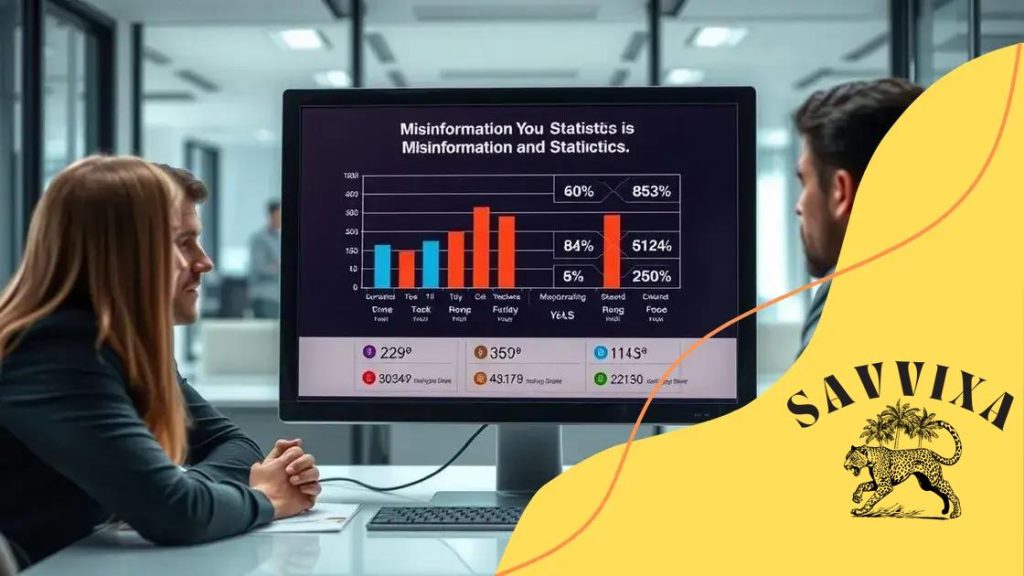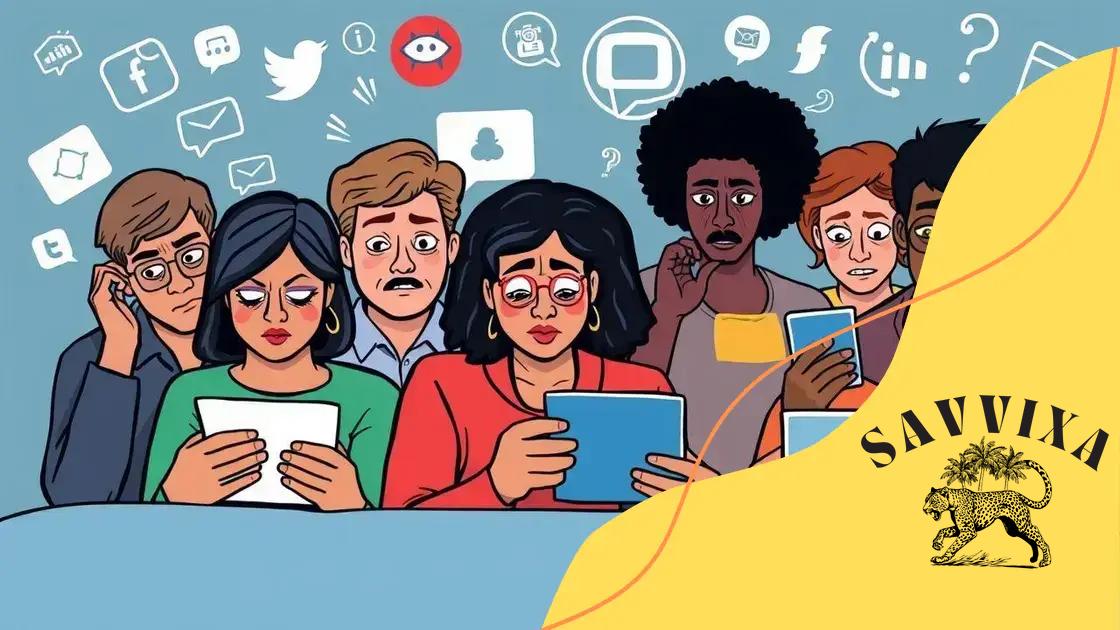AI’s role in combating global misinformation

AI plays a crucial role in combating global misinformation by providing advanced detection tools, enhancing fact-checking processes, and promoting media literacy to ensure the public can discern credible information from falsehoods.
AI’s role in combating global misinformation is becoming increasingly important as technology evolves. Have you ever wondered how AI can sift through the noise online? In this article, we will delve into the ways AI is enhancing our ability to discern truth from falsehood.
Understanding global misinformation
Understanding global misinformation is vital in our digital age. Every day, we encounter information that may not be true. Misinformation spreads quickly, often making it hard to differentiate between what is real and what is not. So, what exactly is global misinformation? It refers to inaccurate or misleading information that circulates and can influence opinions and behaviors worldwide.
Types of Misinformation
There are several forms of misinformation, including:
Recognizing these types can help individuals better navigate the online landscape. The rise of social media has amplified the spread of misinformation. Posts can go viral in minutes, reaching millions and altering perceptions swiftly.
Why Does Misinformation Matter?
Understanding the impact of misinformation is crucial. It can lead to panic, social division, and distrust in important institutions. For example, during a health crisis, misinformation can spread dangerous health advice, causing harm to the public. This illustrates that what we see online matters and can have real-world consequences.
Moreover, misinformation can manipulate elections and influence public opinion. Awareness and education about the dangers of false information can strengthen our understanding of these issues.
Combating Misinformation
Many tools are now available to combat misinformation. Fact-checking organizations work daily to debunk false claims. Social media platforms are also developing AI technologies to identify and flag misleading content.
By utilizing these tools and resources, people can become more informed and critical of the information they consume.
In summary, understanding global misinformation is essential for navigating our information-saturated world. Recognizing its forms, impacts, and the strategies available to combat it empowers individuals and communities.
How AI detects false information
How does AI detect false information? This process involves several complex techniques designed to analyze large amounts of data quickly and accurately. By utilizing various algorithms and machine learning models, AI can identify patterns that suggest misinformation. These technologies are essential for curbing the spread of falsehoods on the internet.
Machine Learning Algorithms
Machine learning plays a crucial role in detecting misinformation. Algorithms can learn from data and improve over time. Natural Language Processing (NLP) is a branch of AI that helps machines understand and interpret human language. NLP helps identify misleading information in texts by analyzing context and language usage.
Some of the techniques used by AI to detect false information include:
These tools help in flagging content that may need further review, allowing human fact-checkers to dive deeper into potential falsehoods.
Data Sources and Verification
Another significant aspect of AI in this field is the analysis of data sources. By cross-referencing claims with trusted databases, AI can assess the reliability of the information presented. This process involves:
AI can monitor thousands of posts per minute, allowing it to swiftly detect emerging misinformation trends. This is especially important during crises, where timely and accurate information is crucial.
Overall, the ability of AI to detect false information is continually evolving. By combining various techniques, AI systems become more adept at identifying and flagging misinformation. This not only helps in protecting users from false claims but also promotes a more informed society.
The impact of misinformation on society

The impact of misinformation on society can be profound and far-reaching. In recent years, we have seen how false information can shape public opinion, influence elections, and even affect people’s health decisions. The consequences of misinformation extend beyond individual choices and can ripple through entire communities and countries.
Creating Confusion and Fear
One major consequence of misinformation is the confusion it creates. When people are presented with conflicting information, it can lead to uncertainty about important issues. For example, during a health crisis, misinformation can spread panic and fear, causing people to make decisions that may not be in their best interest. Furthermore, misinformation can distort facts, making it difficult for the public to understand key issues.
Some specific effects include:
Additionally, the rapid spread of information on social media amplifies these effects. False information can go viral in a matter of hours, impacting hundreds of thousands of people before it is even addressed.
Impact on Democratic Processes
Misinformation plays a crucial role in undermining democratic processes. During elections, for instance, false narratives can influence voter decisions and lead to misinformation campaigns aimed at discrediting candidates or parties. This manipulation can deter individuals from participating in the electoral process, believing their votes do not matter.
Educating voters about misinformation is essential, as is fostering critical thinking skills to help individuals evaluate the information they encounter. Building awareness can also help combat the less overt forms of misinformation, such as misleading statistics and cherry-picked data.
The effects of misinformation on society highlight the urgent need for effective solutions. People need to be equipped with the tools to differentiate between reliable and unreliable information sources. Awareness initiatives can empower individuals, reducing the overall impact of misinformation.
AI tools for fact-checking
AI tools for fact-checking have become essential in the fight against misinformation. As false information spreads quickly, having reliable tools to verify claims helps maintain the integrity of news and data. These AI solutions analyze content efficiently, making it easier for organizations and individuals to discern truth from falsehood.
The Role of AI in Fact-Checking
AI-powered fact-checking tools use algorithms to evaluate the accuracy of statements. They can search vast databases of verified facts in seconds. This speed is crucial, especially during critical situations like elections or emergencies.
Some popular AI tools include:
These tools empower journalists and the public by providing immediate access to verified information. They reduce the burden on human fact-checkers, allowing them to focus on more complex inquiries.
How AI Improves Fact-Checking Efficiency
The efficiency of AI in fact-checking lies in its ability to learn and adapt over time. Machine learning algorithms improve their accuracy by analyzing patterns in data. For instance, they become better at spotting language cues that often indicate misinformation.
Additionally, AI can detect subtle variations in wording, making it easier to recognize when false claims are repackaged. This capability is essential as misinformation evolves, requiring constant vigilance against new tactics.
As misinformation becomes more sophisticated, AI tools for fact-checking will also need to advance. Continuous upgrades and innovations will play a significant role in combating false narratives while ensuring that the public has access to trustworthy information.
Future trends in AI and misinformation
Future trends in AI and misinformation are becoming increasingly important as technology evolves. As more people rely on digital platforms for information, understanding how AI will shape this landscape is crucial. Experts believe that AI will play a significant role in both combating and potentially exacerbating misinformation in the coming years.
Advancements in AI Detection Tools
As technology continues to develop, AI detection tools will become more sophisticated. This will enable them to identify misinformation more accurately and efficiently. With improvements in machine learning algorithms and natural language processing, AI will learn to recognize nuances in language that could indicate false information.
Some anticipated advancements include:
These advancements will empower users to trust the information they receive and reduce the spread of falsehoods online.
Personalization and AI Filters
Another trend is the personalization of content through AI filters. As algorithms learn about user preferences, they can curate news feeds that prioritize reliable information. This might reduce exposure to misinformation by helping individuals avoid sensational content.
However, this also raises concerns. While personalization can help, it can also lead to echo chambers, where users only see information that confirms their beliefs. Addressing this challenge is essential to ensure a balanced flow of information.
As we look to the future, collaboration between tech companies, fact-checkers, and governments will be vital. This partnership can help ensure that the tools being developed to fight misinformation are effective and safeguard democratic processes.
The future interaction between AI and misinformation presents exciting opportunities and daunting challenges. Staying informed about these trends can help individuals navigate the ever-changing landscape of information.
FAQ – Frequently Asked Questions about AI’s Role in Combating Misinformation
How does AI help detect misinformation?
AI uses advanced algorithms to analyze large amounts of data quickly, identifying patterns that indicate false information.
What are AI tools for fact-checking?
AI tools for fact-checking verify claims by cross-referencing them with trusted databases and reliable sources.
Why is media literacy important?
Media literacy helps individuals discern credible information from misinformation, making them more informed consumers of news.
What future trends should we expect in AI and misinformation?
Future trends may include improved detection tools, enhanced multilingual capabilities, and more collaboration between tech companies and fact-checkers.